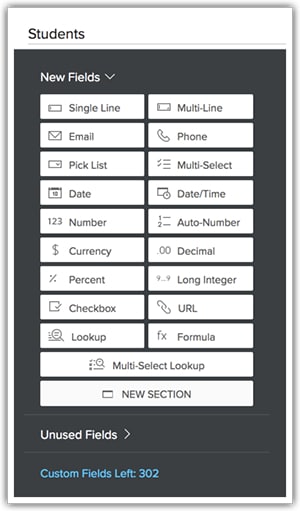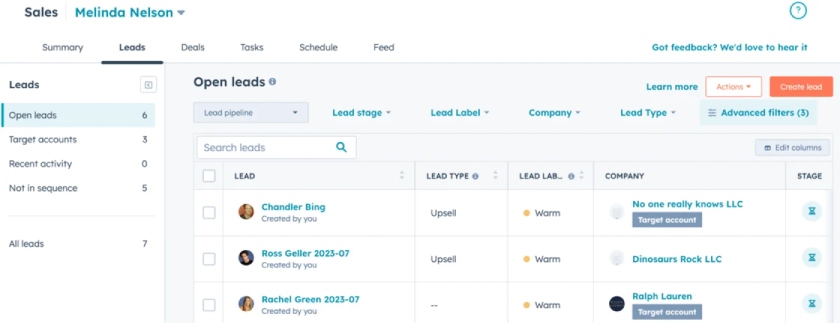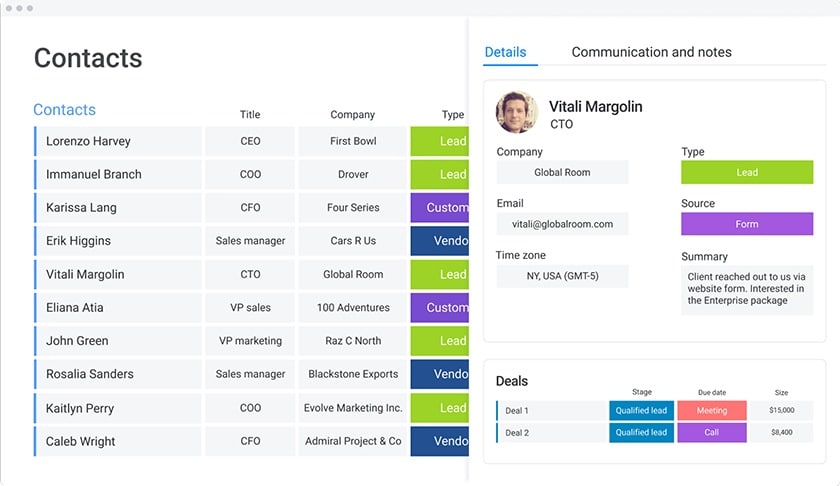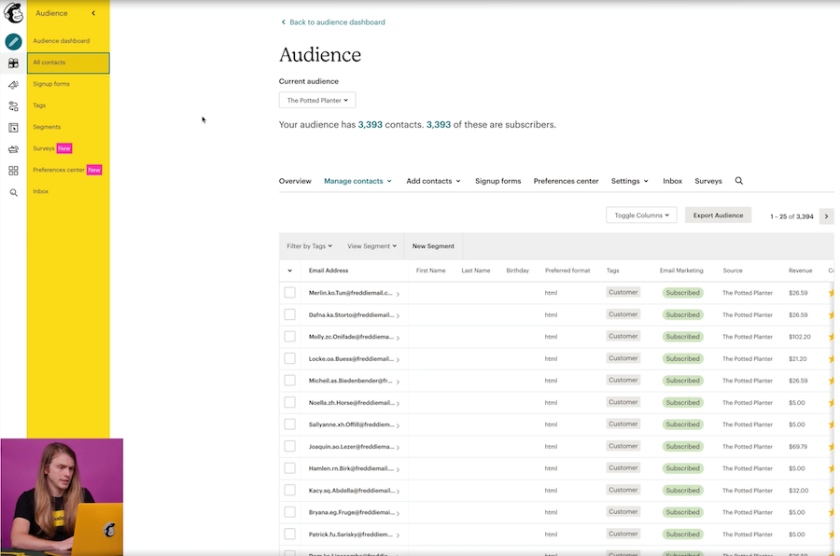Lead tracking is storing, organizing, and updating prospect data and sales activity information. To perform this process, you’ll need a sales leads tracking tool and then start by defining the types of data you want to collect.
Once that’s established, keep the information updated as you generate, assign, qualify, and nurture leads and finalize sales deals. Here, we explore how to track sales leads and properly organize lead information and why it’s important to track them.
Tracking sales leads is essential to a standardized sales operation. We’ve created a free template to make it easier for you to get started. You can use this spreadsheet to organize prospects or guide you in defining and setting up your sales lead tracker.
Thank you for downloading!
💡 Quick Tip:
Customer relationship management (CRM) systems like HubSpot allow you to organize, prioritize, and engage your leads in a centralized platform. This provider also allows you to automate lead assignments and follow-ups.
What is lead tracking?
Lead tracking is the process of monitoring the journey of your potential customers through the sales process. It involves gathering contact and interaction details through various channels, including emails, websites, and social media.
This process also includes noting key actions that show the prospect’s level of interest in your brand. These steps help businesses spot high-potential leads, create personalized marketing messages, and reach out to prospects at the right time.
Benefits of sales lead tracking
Sales lead tracking offers several benefits which include better marketing campaigns, more qualified leads, and personalized content. These ultimately lead to higher conversion rates and better resource allocation. Check out my detailed breakdown of these benefits.
Better marketing campaigns
Lead tracking helps you understand which marketing campaigns, channels, and strategies bring in the most engagement and conversions. This, in turn, helps you allocate your resources more effectively and adapt your messaging to make it more relevant and timely.
For example, if your tracking tool shows that email newsletters yield higher-quality leads compared to webinars, you invest more time and resources in promoting your newsletters.
More qualified leads
Tracking lead behavior and engagement patterns helps businesses identify the prospects that are most interested in your brand and have the highest likelihood of converting. It also helps marketing teams reduce time tending to low-potential contacts and prioritize leads that are aligned with your ideal customer profile.
For instance, a lead that has visited your pricing page, scheduled a demo, and downloaded several resources are more sales-ready than someone who only browsed your career page.
Personalized content
Aside from improving marketing campaigns and lead quality, detailed lead tracking also helps businesses tailor their content based on prospects’ interests, online behaviors, and pain points. It provides you with insights into the topics that leads engage in, enabling you to deliver personalized emails and offers.
For example, you can increase the likelihood of conversion of a lead who frequently visits content about baby needs by nurturing them with product demos focused on these products.
How to track leads in 5 steps
Tracking leads involves several steps that start with leveraging a sales lead tracking tool and defining your data fields. Then, you need to implement a lead scoring system, track leads’ email activities, and analyze your sales report.
1. Use a sales lead tracking tool
The first thing to do is to determine the tool or method you’d like to use. Depending on your technical knowledge of sales leads software, the complexity of your sales process, and the amount of information you need to manage, there are a few routes you can take to track sales leads
While there are many methods for organizing sales information, 40% of sales professionals agree a CRM provides them with a better way to align sales and marketing teams. No matter what type of CRM you choose for tracking your leads, the most important thing is that you and other users can store and update applicable data records as events take place. These include CRM records, spreadsheet cells, project management items, and email contact lists.
2. Define data fields
Once you’ve decided how to organize the prospect and deal information, there’s a small but necessary step of defining data fields before you can set up and begin tracking. Fields are where you collect information associated with a lead record. For example, an important data field for a lead is the lead contact’s first and last name.
Review the types of data fields you should define and include in your sales tracking.
The first type of data field involves contact information associated with a lead. This field helps identify a record because the information is unique to that specific lead. The most common examples you want to collect for each lead include their name, organization, address, email address, and phone number.
Tracking lead sources helps you monitor where opportunities are coming from to help optimize marketing budgets and sales resources to the most effective channels. Some examples of lead sources include trade shows, networking events, social media, online ads, inbound calls, business referrals, online research, or a specific organization. Keep in mind that a lead source is simply where your prospects heard about you or first interacted with you.
Deal information fields include data regarding their purchase potential and product or service interest. Common examples include deal size ($) and the product line the lead is interested in. This category also encompasses any information that impacts pricing, such as the number of employees, which often dictates how much insurance, software, or a consulting service costs.
These data fields let you monitor where you are in the sales process with each opportunity. You might have established predefined pipeline stages that indicate the internal activities required to close a deal, such as lead qualification, nurturing, or sending proposals. Alternatively, you might take a simpler approach and just take note of your interactions with them.
For example, if a prospect called into your business on August 1, you’d note in their record, “Aug 1: Lead generated — called with interest in products.” Then, if you followed up with them on September 1, you’d add to the record “Sept 1: Followed up on lead by calling them, couldn’t speak but asked me to send an email, email sent.”
3. Implement a lead scoring system
A lead scoring system assigns points to leads based on their profile and behavior, helping prioritize high-potential prospects. Positive actions — like opening emails, attending webinars, or requesting a demo — increase a lead’s score, while negative signals — such as unsubscribing or inactivity — may lower it. By focusing on high-scoring leads, sales teams can improve their conversion rates and allocate time more efficiently.
Once you’ve determined what to track, begin setting up your lead tracking system. Start with adding those data fields you find essential. If you’re using a spreadsheet, create a column for each action you want to track. If you’re using CRM software, each product will have default fields to work with or its custom settings for adding and editing custom fields for each module.
Zoho CRM, for example, lets you select field types, such as single line text, date, email, or a check box, and then label the field with the relevant name, such as Social Security number, lead name, or lead source. Users can also edit properties for each field in the CRM if they require data entry for the record, want to prevent duplicates, or need to secure the data with encryption.

Zoho CRM custom data field types. (Source: Zoho)
4. Track email activity
Track email engagement metrics like email opens, link clicks, and replies to a lead’s gauge engagement and interest level. For example, if a lead consistently opens your emails and clicks product links, they may be closer to making a purchase. Many email marketing platforms, like Mailchimp or ActiveCampaign, provide built-in tracking features for this purpose.
ActiveCampaign email tracking data. (Source: ActiveCampaign)
5. Analyze sales reports
Regularly reviewing sales reports helps assess lead quality and identify patterns in successful conversions. Tracking metrics such as lead-to-customer conversion rates, average sales cycle length, and the most common lead sources allows you to refine your strategies. By analyzing this data, you can improve lead targeting, adjust scoring models, and enhance overall sales performance.
Frequently asked questions (FAQs)
Lead tracking is the process of managing and monitoring potential customers’ journeys through the sales funnel. This process helps teams stay on top of their tasks, improve customer engagement, and increase conversion rates.
If you’re not using a CRM system, you can track leads manually using Google Sheets or a Microsoft Excel spreadsheet template. You can also use project management tools like monday.com and email marketing platforms like Mailchimp to track your sales leads, which has a feature called Track that gathers data about landing pages or website activities, saves the data on contact profiles, and lets you use it to segment audiences.
A lead tracker should include identifiable information about leads, such as their name, organization, address, email address, and contact number. It should also have the lead source, associated tags, deal information, and pipeline stage or relevant activity.
It’s important to track leads to obtain relevant information that can help your sales team drive conversions. These include data on how the leads contacted your company and what their pain points are. You can use these details to personalize your outreach efforts and get better engagement.
To track lead quality, you need to use a lead scoring system to assign points to each lead based on their demographics, behavior, and engagement. Then, monitor key metrics like email interactions, website visits, and conversion rates to assess intent. Lastly, regularly gather feedback from your sales team to refine your scoring criteria and improve its accuracy.
Bottom line
Tracking sales leads is storing and updating prospect information as they’re generated and undergo the sales process. It’s essential to keep your sales data organized to ensure reps have access to the most recent and relevant information. A robust lead tracking system requires you to select a method you’re comfortable with, such as a CRM, identify the information you want to store, and keep updating records as events take place.


